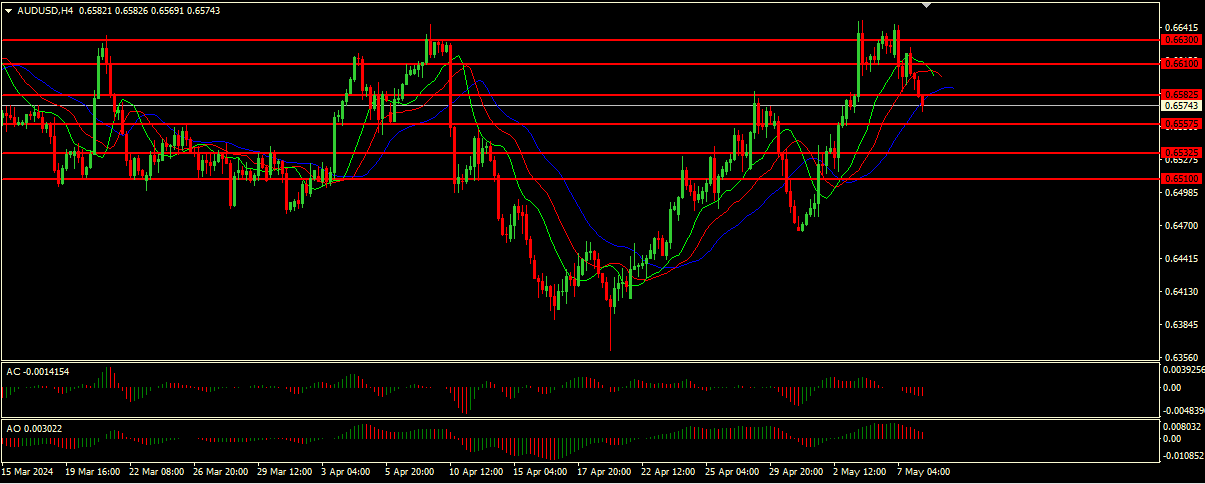Fundamental analysis AUD/USD for 08.05.2024
The Australian Dollar (AUD) has experienced significant fluctuations, primarily influenced by the Reserve Bank of Australia's (RBA) recent decision to maintain its interest rate at 4.35%. Despite the anticipation of a hawkish shift following unexpectedly high inflation figures, the RBA has maintained a cautious approach, citing the need for vigilance against inflation risks. Governor Michele Bullock underscored the necessity of maintaining current rates to guide inflation back to the target range of 2-3% by the latter half of 2025.
Australia's 10-year government bond yield fell to 4.3%, its lowest level in two weeks. The fall followed the RBA's decision to leave key interest rates unchanged. The lack of overtly hawkish signals that many market participants had expected also contributed to the lackluster reaction.
The ASX 200 index continued its upward trend for a fifth straight session after the Reserve Bank of Australia eased its hawkish stance following Tuesday's monetary policy decision. Significant gains were observed among major companies in the index, including Commonwealth Bank, Wesfarmers and Woodside Energy. Societe Generale has released a note on the Reserve Bank of Australia, highlighting that the Reserve Bank of Australia's optimism about economic growth is misplaced. The institute expects Australia's economic growth to decline, with the possibility of an unexpected downturn. They attribute this prediction in part to the wider impact the RBA rate hike is having on the economy.
Judo Bank Australia's composite Purchasing Managers' Index (PMI) fell in April, suggesting that growth in Australia's private sector output has slowed slightly. Growth in business activity was mainly limited to the service sector, and manufacturing production continued to decline. The RBA rate is expected to peak at 4.35% in November 2023 and fall to 3.10% by December 2025, according to forecasts from analysts at Commonwealth Bank and Westpac.
On the other side of the Pacific, the US Dollar (USD) has strengthened, driven by the Federal Reserve's (Fed) signals to sustain higher interest rates for a prolonged period. Fed officials, including Minneapolis President Neel Kashkari, have hinted that while rate increases are not imminent, they are not off the table, which has bolstered the USD, adversely affecting the AUD/USD exchange rate.
Looking forward, the AUD/USD pair faces multiple influencing factors. The upcoming release of the RBA's economic charts and ongoing economic data releases from China will play significant roles in shaping market sentiment. Additionally, investor focus will be on the FOMC members' speeches, which could further impact the exchange rate dynamics if they hint at continued or enhanced hawkish Fed policies. Meanwhile, any signs of weakening in the US labor market or inflation could alter Fed expectations, potentially providing some relief to the pressured AUD.
Overall, the AUD/USD pair is navigating through a landscape shaped by central bank policies, economic data releases, and global market sentiment, with each new piece of data potentially swaying the balance in this finely tuned economic environment.
Technical analysis and scenarios:

Considering that the Alligator indicator is "sleeping" along with the twisted moving averages, this suggests that the market is now in a consolidation phase without a clear trend. However, the presence of the Awesome Oscillator (AO) and Accelerator Oscillator (AC) in the red zone and near the zero level indicates an increase in bearish momentum. This situation often indicates a potential downward move.
Main scenario (SELL)
Recommended entry level: 0.65575
Take profit: 0.65325
Stop loss: 0.65825
Alternative scenario (BUY)
Recommended entry level: 0.65825
Take profit: 0.66100
Stop loss: 0.65575
